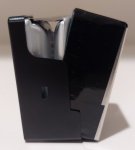Just some reading from a reputable source...
What Makes Lithium Batteries Swell?
So let’s get down to why lithium batteries swell. Remember that what’s going on inside a battery to create energy is a chemical reaction. In the case of a lithium battery, that reaction involves electrons and electrolytes flowing from one end to the other.
Anything that disrupts the energy-producing chemical reaction going on inside the battery will create excess gas that has to go somewhere – so it tries to escape by pushing out on the exterior of the battery case. If you’ve ever taken a chemistry class, you may recall that when a chemical reaction is interrupted, a byproduct can be created. In this case, it’s gas, and it’s not good.
Why Do Lithium Batteries Swell?
The University of Illinois at Urbana-Champaign reminds us that the lithium-ion battery packs found in our everyday devices come with a built-in Battery Management System to help control the charging process and prevent that gas buildup. However, for the battery and management system to be able to do their jobs, the batteries need to be cared for.
So what can disrupt that chemical reaction in the battery and create gas, therefore causing a swollen battery? Let’s refer to our list above.
Extreme Temperatures
Many experts suggest this is the most common reason for a swollen battery. A study in the Electrochemical Society by the Samsung Energy Development Team of Samsung SDI Co., Ltd looked into the swelling properties of lithium-ion batteries. It showed that when stored at 194℉ (90℃) for four hours, the batteries expanded. The most swelling occurred in batteries that were fully charged.
According to the University of Illinois at Urbana-Champaign, consumers should always follow the manufacturer’s guidelines, including recommended storage requirements, temperature, and voltage.
Poor Quality or Damaged Battery
A poorly made (low-quality or cheap) battery sometimes just doesn’t perform correctly. Errors in its chemical reaction can cause the gas to build up, and each time you charge or try to use your device, more gas is released.
When in doubt, opt for a name-brand battery from a company you can trust.
Issues With Charging – Overcharging, Faulty Equipment, or Deep Discharging
Excessive overcharging of a battery or using a low-quality charger can put stress on the battery, causing that gas to build up and even causing the battery to discharge (lose its charge) quicker. Experts suggest you don’t leave your battery charging all the time. Unplug it and give it a chance to perform its function.
Why Do Lithium Batteries Swell?
Should I Be Concerned About a Swelling Lithium Battery?
According to Dell, a computer company well-versed in lithium-ion polymer batteries, a swollen battery may impact the performance of your device but doesn’t pose a safety issue. Pay attention for signs of a swollen battery, such as a gap between components, an uneven surface of your battery-powered device, or cracks. Unplug the device, power it down, and replace the swollen battery as soon as it’s detected.
If left unchecked, the University of Illinois says a swollen lithium battery can continue to generate more gas and create heat, eventually rupturing the battery. In severe cases, with the heightened temperature, flammable electrolyte, plus oxygen, a fire could occur.
What to Do With a Swollen Lithium Battery
Carefully remove a swollen lithium battery and identify an organization that will recycle it – do not throw it away, put it in a standard recycling bin, or put it in the water at any time. Never puncture a swollen battery.
I Fix It suggests locating a local e-waste collection site who will properly dispose of it. Visit their e-waste page to read the local regulations in your state and find a local establishment near you. Apple takes back its own batteries, and Best Buy recycles many types. Do a bit of research, and you’re sure to find a suitable place to recycle your old lithium battery.
Conclusion
Lithium batteries swell when the chemical reaction happening inside is disrupted. Factors that can cause this include extreme temperatures, poor quality or damage to the battery, or issues with charging. Remember that all batteries need replacing eventually, but ensure you get yours to the finish line without swelling by taking great care of your battery as the manufacturer intended.




